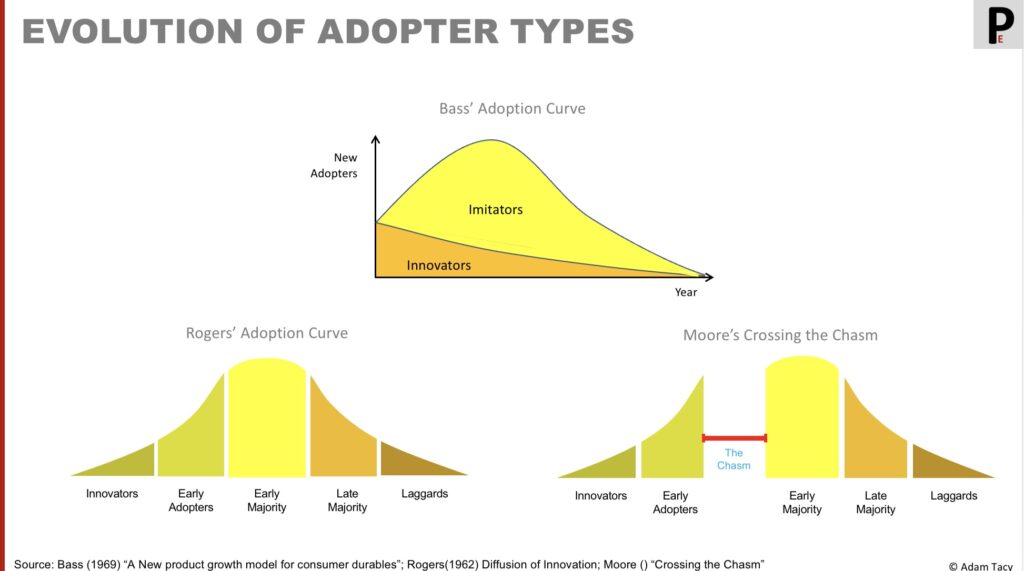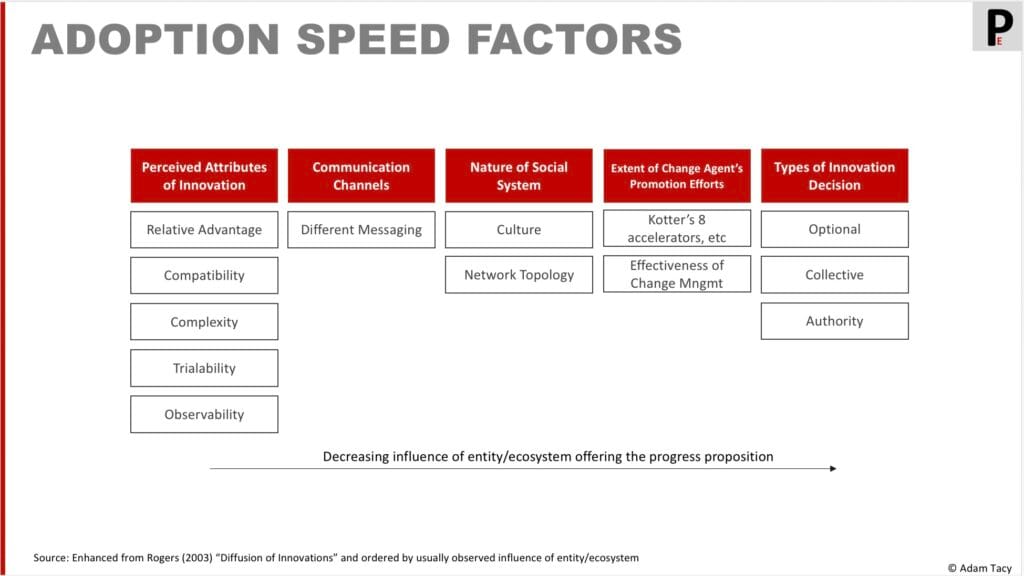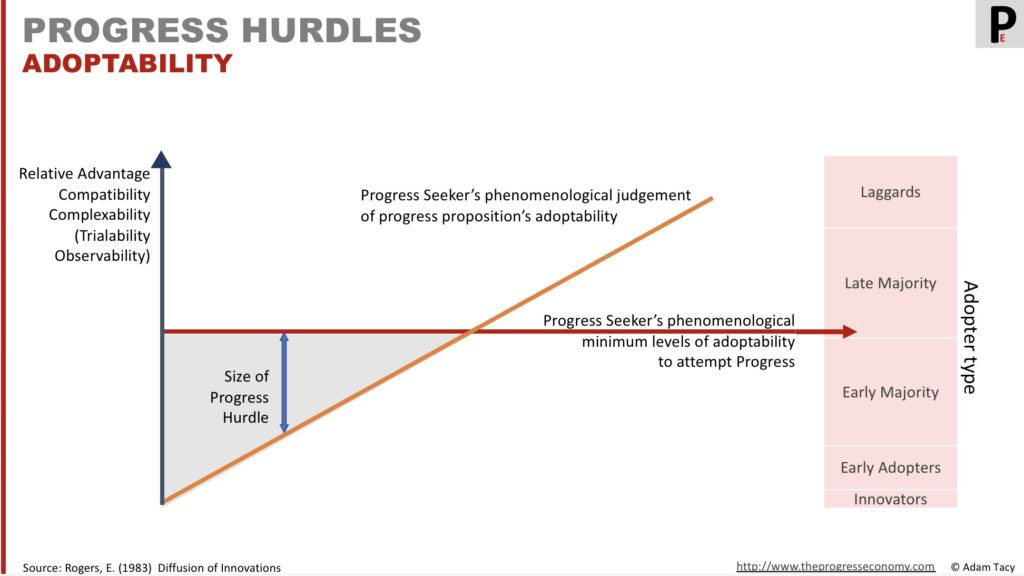What we’re thinking
We’re leveraging some of Rogers’ innovation adoption theory as a progress hurdle.
Specifically his adopter types and his five perceived attributes affecting adoptability of innovations – complexity, relative advantage, compatibility, trialabilty and observability.
Adoptability – a progress hurdle Share on XA seeker has to feel they can adopt a proposition to begin engaging it to attempt progress. This goes hand in hand with the resistance progress hurdle.
And a seeker’s adopter type gives an insight into how high they see this hurdle.
Adoptability
If a seeker cannot envision themselves using your proposition, the likelihood of engagement diminishes, resulting in you missing out on service exchanges.
The concept of a seeker engaging with your proposition aligns closely with the idea of someone adopting an innovation. Something extensively explored by Rogers in his well known work, “Diffusion of Innovations“.
getting a new idea adopted, even when is has obvious advantages, is difficult
Rogers (2003) – Diffusion of Innovation
Rogers’ research gives us many insights, two of which we leverage as this progress hurdle. Namely that there are:
- different profiles (types) of adopters
- five perceived attributes that affect speed of adoption
Let’s take a look at these before exploring the related hurdle.
Adopter types
It turns out that as seekers we can be grouped into adopter types based on how likely we are to adopt an innovation.

Rogers defines the following five adopter types:
- Innovators – the risk-takers who are excited by new things and are about 2.5% of your target market
- Early adopters – trendsetters/influencers, around 13.5%
- Early Majority – the pragmatists, around 34%, and start adopting when they see your innovation as mostly stable
- Late Majority – the cautious, another 34%, who need proof that innovations are working and in widespread use
- Laggards – the sceptics who love the status quo and are going to require a lot of change work to adopt
The background is that innovations are increasingly adopted across a society in roughly the order above. If an innovation stalls in one segment it is unlikely to gain widespread use in the segment to the right.
Bass provides mathematical foundations to the adoptability curve that are interestingly accurate to real world examples. If you want to get your geek on, with exploration of the formula, Bass co-efficients, links to spreadsheets and examples; head over here!
Whereas Moore, in his book “Crossing the Chasm”, looked at hi-tech innovations and identified a chasm between the early adopters and early majority that needs attention to cross.
These adopter types loosely guide where a seeker will judge their minimum levels in the progress hurdle will be.
Perceived attributes
Rogers also identified a number of factors affecting the speed of a society adopting an innovation.

We repurpose these as factors affecting the adoption hurdle
For now we’ll focus on the perceived attributes factor. These can readily be applied to individual seeker decisions to engage or not. Noting that the other factors may be found as important during our continued exploration of the progress economy. Our hurdle then is concerned with:
- Relative advantage
- Compatibility
- Complexity (Simplicity)
- Trialability
- Observability
Relative advantage
the degree to which an innovation is perceived as being better than the idea it supersedes
Rogers (2003) – Diffusion of Innovation
Does the proposition have a relative advantage over existing propositions (including attempting progress yourself)? And in the progress economy, relative advantage means some combination of:
- being able to make existing progress better (faster, safer, simpler,…)
- being able to make more progress towards progress sought
- having reduced other progress hurdles
If a proposition doesn’t have a relative advantage to a progress seeker, they are less likely to engage it.
Compatibility
the degree to which an innovation is perceived as consistent with the existing values, past experiences, and needs of potential adopters
Rogers (2003) – Diffusion of Innovation
The adoptability hurdle is lower when a progress proposition aligns with seekers’ existing experiences (not necessarily in your market or industry).
Innovation researchers often highlight how computer keyboards having a QWERTY layout. There’s no technical reason why this is so. But they are compatible to type-writing machines (where QWERTY layout reduced collisions between hammers printing on paper).
Now it’s useful to reflect that we are talking hurdles not barriers. If every proposition had to be compatible then we’d risk limiting innovation to incremental and disallow radical innovation.
Complexity (Simplicity)
the degree to which an innovation is perceived as relatively difficult to understand and use
Rogers (2003) – Diffusion of Innovation
If a proposition is too complex then a seeker may decide not to engage. For our purposes, we’re better of seeing this as “simplicity” to avoid having a separate axis on our visualisation.
As hurdles are regularly judged by seekers during progress attempts, we can identify that regular dialogue with a seeker during a progress attempt could be beneficial.
Despite the general principle of minimizing complexity, the Snapchat application presents an interesting example. Its interface, complex for most adults to use, is cherished by teenagers, partly because it keeps parents out. This shows we should play good attention to progress sought by our target seekers.
Trialability
the degree to which an innovation may be experimented with on a limited basis
Rogers (2003) – Diffusion of Innovation
Allowing a seeker to trial a proposition can lead to lowering the adoptability hurdle. However, unsupervised trialing may have the opposite effect if the seeker becomes frustrated during the trial and has no support (potentially leading to value destruction).
Observability
the degree to which the results of an innovation are visible to others
Rogers (2003) – Diffusion of Innovation
Lastly, if the seeker can observe the proposition being used by others around them, then the adoptability hurdle can be reduced.
Adoptability Progress Hurdle
Now we can pull all the above together to define the adoptability progress hurdle. Here’s how we visualise it.

The left, as normal has the aspect under consideration. In this case the five attributes (remembering that, to simplify the visualisation, complexity means reducing complexity as we go upwards, ie simplicity).
Over on the right we have the adopter types. We can adjust the horizontal seeker’s judgement up and down based on where we think a seeker sits as an adopter. Seekers who are innovator type, for instance, likely accept lower levels of the perceived attributes than a seeker who identifies as being in the late majority.
Relating to Value
Like the other progress hurdles, the higher the size of the hurdle, the less likely a seeker will engage.
Relating to innovation
Innovation should work to generally reduce this hurdle. Make things with a higher relative advantage, more compatible, less complex. And enable trialability and observability.
However, as we have seen, we really need to understand seekers’ progress sought.
Offering me a mini-nuclear reactor to provide my power needs is not something I can envisage myself doing. Even if back in 1963 Sweden was seemingly heading that way. It is somewhat complex and doesn’t give me much advantage over attaching solar panels or connecting to the national power grid.

Let’s progress together through discussion…